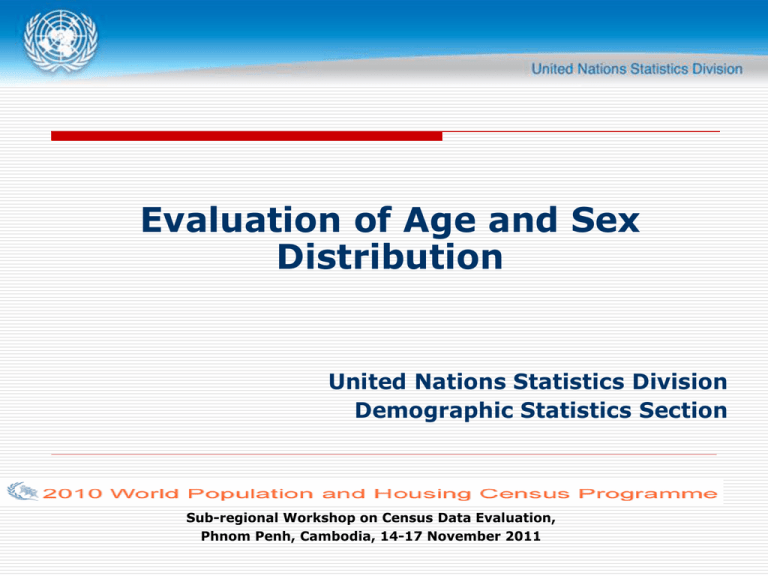PPT
advertisement

Evaluation of Age and Sex Distribution United Nations Statistics Division Demographic Statistics Section Sub-regional Workshop on Census Data Evaluation, Phnom Penh, Cambodia, 14-17 November 2011 Overview of Presentation Population pyramid Graphical cohort analysis Age ratios Sex ratios Whipple`s index Myers`s Blended Method Advantages and limitations Sub-regional Workshop on Census Data Evaluation, Phnom Penh, Cambodia, 14-17 November 2011 Importance of age-sex distribution Age and sex are critical variables in understanding population change of all kinds Practically everything varies with age Errors in age-sex distribution have strong effect on other characteristics of a population Age-sex distribution of a population is determined by fertility, mortality and migration, therefore it follows fairly predictable pattern Evaluation of the reasonableness of the distribution of the population by age and sex can provide considerable insight into the quality of the census enumeration Sub-regional Workshop on Census Data Evaluation, Phnom Penh, Cambodia, 14-17 November 2011 Objectives of evaluation Age-sex distribution should be evaluated to understand; Possible types of error in age-sex structure such as age misreporting, under enumeration, etc. Significant discrepancies in age-sex distribution because of extraordinary events such high migration, war, famine, etc. Sub-regional Workshop on Census Data Evaluation, Phnom Penh, Cambodia, 14-17 November 2011 Approaches for collecting data on age Age is defined as the interval of time between the date of birth and the date of the census Two approaches The date of birth (year, month and day) Completed age (age at the person`s last birthday) First approach gives more precise information and should be used whenever most people know their birth date Second approach is likely to provide less accurate information and lead to age misreporting particularly for children under one year of age and rounding the nearest age ending with zero or five Sub-regional Workshop on Census Data Evaluation, Phnom Penh, Cambodia, 14-17 November 2011 Population Pyramid The population pyramid displays the size of population enumerated in each age group (or cohort) by sex It is basic procedure for assessing the quality of census data on age and sex The base of the pyramid is mainly determined by the level of fertility in the population, while the peak is determined by previous level of mortality and fertility The levels of migration by age and sex also affect the shape of the pyramid Sub-regional Workshop on Census Data Evaluation, Phnom Penh, Cambodia, 14-17 November 2011 Sub-regional Workshop on Census Data Evaluation, Phnom Penh, Cambodia, 14-17 November 2011 Sub-regional Workshop on Census Data Evaluation, Phnom Penh, Cambodia, 14-17 November 2011 Sub-regional Workshop on Census Data Evaluation, Phnom Penh, Cambodia, 14-17 November 2011 Population Pyramid An examination of the data by single years of age provides a closer look at the patterns of error suggested by the population pyramid Population pyramid of Yemen indicates; Under enumeration of young children (under age 2) Age misreporting errors among adults is significant High fertility level Less population in 20-24 age group might be as a result of extraordinary events in 1950-55 period Further investigation would be needed to assess the size of under enumeration of young children and the level of age misreporting in old age cohorts Sub-regional Workshop on Census Data Evaluation, Phnom Penh, Cambodia, 14-17 November 2011 Sub-regional Workshop on Census Data Evaluation, Phnom Penh, Cambodia, 14-17 November 2011 Sub-regional Workshop on Census Data Evaluation, Phnom Penh, Cambodia, 14-17 November 2011 Sub-regional Workshop on Census Data Evaluation, Phnom Penh, Cambodia, 14-17 November 2011 Graphical cohort analysis When two or more censuses available, the graphical techniques may be used to examine the consistency of age structure in consecutive censuses It provides comparison of actual cohorts over multiple censuses The size of each cohort should decline in censuses due to mortality under the assumption of no significant international migration The age structure (the lines) for censuses should follow the same pattern in the absence of census errors An important advantage is that it is possible to evaluate the effects of extraordinary events and other distorting factors by following actual cohorts overtime Sub-regional Workshop on Census Data Evaluation, Phnom Penh, Cambodia, 14-17 November 2011 Sub-regional Workshop on Census Data Evaluation, Phnom Penh, Cambodia, 14-17 November 2011 Age ratios In the absence of sharp changes in fertility or mortality, significant levels of migration or other distorting factors, the enumerated size of a particular cohort should be approximately equal to the average size of the immediately preceding and subsequent cohorts The age ratio for a particular cohort to the average of the counts for the adjacent cohorts should be approximately equal to 1 or (100 if multiplied by a constant of 100) Significant departures from this “expected” ratio indicate either the presence of census error in the census enumeration or of other factors Sub-regional Workshop on Census Data Evaluation, Phnom Penh, Cambodia, 14-17 November 2011 Age ratios Age ratio for the age category x to x+4 5 ARx 5 Px 1 ( 5 Px 5 5 Px 5 Px 5 ) 3 100 5ARx = The age ratio for the age group x to x+4 5Px =The enumerated population in the age category x to x+4 5Px-5 = The enumerated population in the adjacent lower age category 5Px+5 = The enumerated population in the adjacent higher age category Sub-regional Workshop on Census Data Evaluation, Phnom Penh, Cambodia, 14-17 November 2011 Sub-regional Workshop on Census Data Evaluation, Phnom Penh, Cambodia, 14-17 November 2011 Sub-regional Workshop on Census Data Evaluation, Phnom Penh, Cambodia, 14-17 November 2011 Sex ratios Sex Ratio = Mx 100 5 Fx 5 5Mx = Number of males enumerated in a specific age group 5Fx = Number of females enumerated in the same age group Sub-regional Workshop on Census Data Evaluation, Phnom Penh, Cambodia, 14-17 November 2011 Sub-regional Workshop on Census Data Evaluation, Phnom Penh, Cambodia, 14-17 November 2011 Sub-regional Workshop on Census Data Evaluation, Phnom Penh, Cambodia, 14-17 November 2011 Sub-regional Workshop on Census Data Evaluation, Phnom Penh, Cambodia, 14-17 November 2011 Whipple`s Index It has been develop to reflect preference for or avoidance of a particular terminal digit or of each terminal digit It varies between 100, representing no preference for “0” or “5” and 500 indicating that only digits “0” and “5” were reported in the census If the heaping on terminal digit “0” and “5” is measured; (P (1 / 5) ( P 25 Index= 23 P30 ...... P55 P60 ) P24 ....... P60 P61 P62 ) Sub-regional Workshop on Census Data Evaluation, Phnom Penh, Cambodia, 14-17 November 2011 100 Whipple`s Index If the heaping on terminal digit “0” is measured; Index= P30 P40 P50 P60 100 (1 / 10) ( P23 P24 ....... P60 P61 P62 ) The choice of the range 23 to 62 is largely arbitrary. In computing indexes of heaping, the ages of childhood and old age are often excluded because they are more strongly affected by other types of errors of reporting than by preference for specific terminal digits Sub-regional Workshop on Census Data Evaluation, Phnom Penh, Cambodia, 14-17 November 2011 Whipple`s Index The index can be grouped in the following categories: Value of Whipple’s Index • Highly accurate data Less than 105 • Fairly accurate data 105 – 109.9 • Approximate data 110 – 124.9 • Rough data 125 – 174.9 • Very rough data 175 and more Sub-regional Workshop on Census Data Evaluation, Phnom Penh, Cambodia, 14-17 November 2011 Sub-regional Workshop on Census Data Evaluation, Phnom Penh, Cambodia, 14-17 November 2011 Myers` Blended Index It is conceptually similar to Whipple`s index, except that the index considers preference (or avoidance) of age ending in each of the digits 0 to 9 in deriving overall age accuracy score The theoretical range of Myers` Index is from 0 to 90, where “0” indicates no age heaping and “90” indicates the extreme case where all recorded ages end in the same digit Sub-regional Workshop on Census Data Evaluation, Phnom Penh, Cambodia, 14-17 November 2011 Sub-regional Workshop on Census Data Evaluation, Phnom Penh, Cambodia, 14-17 November 2011 Sub-regional Workshop on Census Data Evaluation, Phnom Penh, Cambodia, 14-17 November 2011 Uses and limitations Assessment of the age-sex distribution of the population enumerated in a census is typically the first step taken in evaluating a census by means of demographic methods Demographic methods provide: a quick and inexpensive indication of the general quality of data evidence on the specific segments of the population in which the presence of error is likely “historical” information which may be useful for interpreting the results of evaluation studies based on other methods and in determining how the census data should be adjusted for use in demographic analyses Sub-regional Workshop on Census Data Evaluation, Phnom Penh, Cambodia, 14-17 November 2011 Uses and limitations The major limitation of age-sex distribution analysis is that, it is not possible to derive separate numerical estimates of the magnitude of coverage and content error on the basis of such analyses alone It is often possible to assess particular types of errors which are likely to have affected the census counts for particular segments of the population. Estimates of coverage error from other sources often are required to verify these observations Sub-regional Workshop on Census Data Evaluation, Phnom Penh, Cambodia, 14-17 November 2011 THANK YOU ….. Sub-regional Workshop on Census Data Evaluation, Phnom Penh, Cambodia, 14-17 November 2011








